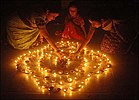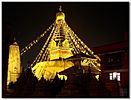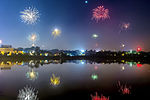HAPPY DIWALI SALE
Diwali or Deepavali is the Hindu festival of lights celebrated every year in autumn in the northern hemisphere (spring in southern hemisphere).[3][4] It is an official holiday in Fiji, Guyana, India,[5] Malaysia, Mauritius, Myanmar, Nepal, Singapore, Sri Lanka, Suriname, Trinidad and Tobago, and recently Sindh Province in Pakistan. One of the most popular festivals of Hinduism, it spiritually signifies the victory of light over darkness, good over evil, knowledge over ignorance, and hope over despair.[6][7][8] Its celebration includes millions of lights shining on housetops, outside doors and windows, around temples and other buildings in the communities and countries where it is observed.[9] The festival preparations and rituals typically extend over a five-day period, but the main festival night of Diwali coincides with the darkest, new moon night of the Hindu Lunisolar month Kartika in Bikram Sambat calendar (the month of Aippasi in Tamil Calendar). In the Gregorian calendar, Diwali night falls between mid-October and mid-November.
Before Diwali night, people clean, renovate, and decorate their homes and offices.[10] On Diwali night, people dress up in new clothes or their best outfit, light up diyas (lamps and candles) inside and outside their home, participate in family puja (prayers) typically to Lakshmi – the goddess of fertility and prosperity. After puja, fireworks follow,[11] then a family feast including mithai (sweets), and an exchange of gifts between family members and close friends. Deepavali also marks a major shopping period in nations where it is celebrated.[12]
The name of festive days as well as the rituals of Diwali vary significantly among Hindus, based on the region of India. In many parts of India,[13] the festivities start with Dhanteras (in Northern and Western part of India), followed by Naraka Chaturdasi on second day, Deepavali on the third day, Diwali Padva dedicated to wife–husband relationship on the fourth day, and festivities end with Bhai Dooj dedicated to sister–brother bond on the fifth day. Dhanteras usually falls eighteen days after Dussehra.
On the same night that Hindus celebrate Diwali, Jains celebrate a festival also called Diwali to mark the attainment of moksha by Mahavira,[14][15] Sikhs celebrate Bandi Chhor Divas to mark the release of Guru Hargobind from a Mughal Empire prison,[16] and Newar Buddhists, unlike the majority of Buddhists, celebrate Diwali by worshipping Lakshmi.[17][18]
Etymology
| |||||||||
Diwali (English: /dɪˈwɑːliː/)[3] or Sanskrit dīpāvali means "series of lights",[21] and is derived from dīpam "light, lamp" and oli "glow of light". Diwali is also known as dīpotsavam "festival of lights".
The holiday is known as dipawoli in Assamese: দীপাৱলী, dipaboli or dipali in Bengali: দীপাবলি/দীপালি, divāḷi in Gujarati: દિવાળી, divālī in Hindi: दिवाली, dīpavaḷi in Kannada: ದೀಪಾವಳಿ, Konkani: दिवाळी, Malayalam: ദീപാവലി, Marathi: दिवाळी, dipābali in Odia: ଦିପାବଳୀ, dīvālī in Punjabi: ਦੀਵਾਲੀ, diyārī in Sindhi: दियारी, 'tīpāvaḷi in Tamil: தீபாவளி, and Telugu: దీపావళి, Galungan in Balinese and Swanti in Nepali: स्वन्ति or tihar in Nepali: तिहार.
History
Diwali dates back to ancient times in India, as a festival after the summer harvest in the Hindu calendar month of Kartika. The festival is mentioned in Sanskrit texts such as the Padma Purana, the Skanda Purana both completed in second half of 1st millennium AD but believed to have been expanded from a core text from an earlier era. The diyas (lamps) are mentioned in Skanda Purana to symbolically represent parts of the sun, the cosmic giver of light and energy to all life, who seasonally transitions in the Hindu calendar month of Kartik.[19][22]
Hindus in some regions of India associate Diwali with the legend of Yama and Nachiketa on Kartika amavasya (Diwali









No comments:
Post a Comment